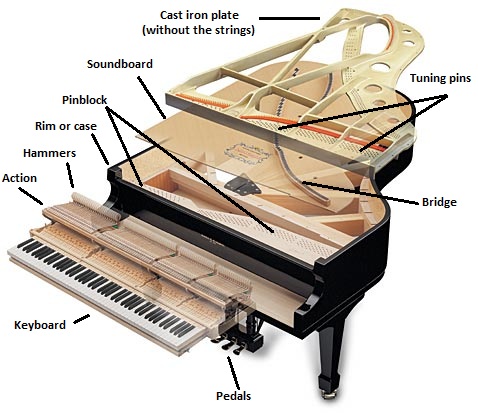History of piano
The piano is a string percussion keyboard instrument with. To become what we call today a modern piano, the first piano instrument went through some changes. To understand how and why these changes occurred we must look back into the past and mention them. But how far should we look back? Ancient Greece? Ancient Egypt? Clearly no. The first instrument that can be called the first ancestor of the piano is more likely to be the clavichord.
Invented in the early fourteenth century, the clavichord (from the Latin word clavis meaning key and chorda from Greek meaning string) was described (at that time) as one of the best instruments to accompany melodies. Pressing the keyboard's keys followed up with strikes of the brass or iron strings with small metal blades called tangents thus, producing sound. Vibrations were then transmitted through the bridge(s) to the soundboard. Bellow you can see a picture with this instrument.
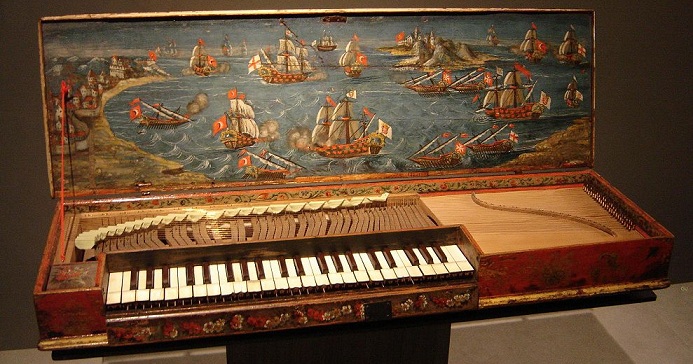
Next in line is the harpsichord, which produces sound by plucking a string (unlike the clavichord which produces sound by striking a string) when a key is pressed. The harpsichord was most probably invented in the late Middle Ages. By the 16th century, harpsichord makers in Italy were making lightweight instruments with low string tension. This instrument was widely used in Renaissance and Baroque music until the piano forte gained popularity. Bellow you can see how an 18th century harpsichord looks like.
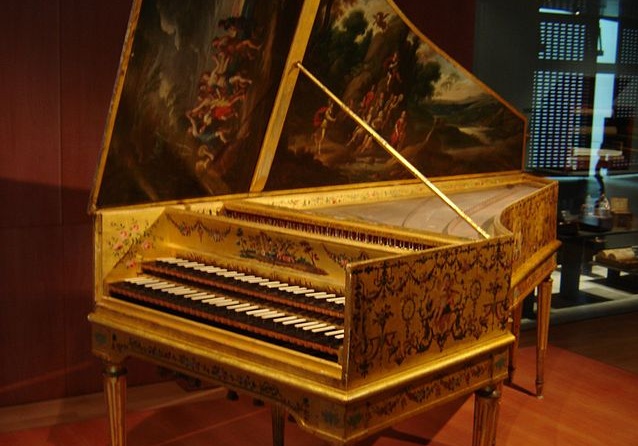
Other variants of this instrument: Virginal, Spinet, Archicembalo, Clavycimbalum, Clavicytherium, Lautenwerk, Ottavino. Although these are variations of the harpsichord, these instruments have specific characteristics which give them an unique timbre.
The early version of the piano was the Fortepiano invented by the Italian instrument maker Bartolomeo Christofori around 1700. This instrument could provide dynamism to music, unlike its close ancestor the harpsichord which didn't offer the possibility of dynamics in sound (basically, all notes had the same volume regardless of the pressure you applied to any key). Bellow you can see how a 19th century fortepiano looks like.
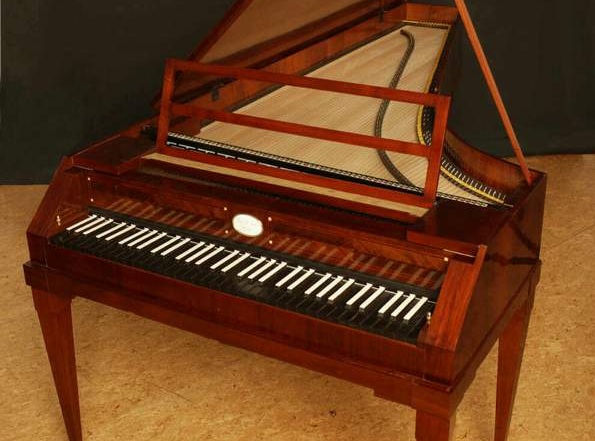
Notice that it is a smaller instrument than the modern piano we know and that the black keys are white and the white keys are black?
It was Christoph Gottlieb Schroter (1721) who later improved the fortepiano by adding a hammer-based mechanic and Gottfried Silbermann (1730) who added the damper pedal (the modern sustain pedal) which lifts all the dampers from the strings simultaneously. Cristofori, Schroter and Silbermann's ideas were developed by Robert Stodart, John Broadwood and Americanus Backers into the foundations of the English mechanics where the hammers were fixed on a wooden rod being directed to the strings using levers; they also use the “echapement” system which means that the key retracts to its original position.
Johann Andreas Stein played an important role in the development of the piano's mechanics, he created a system in which the hammers are placed directly at the end of each lever. Later on Sébastien Érard who invented the double escapement action, which incorporated a repetition lever (also called the balancier) that permitted repeating a note even if the key had not yet risen to its maximum vertical position. Other important manufacturers that played a significant role in the development of the modern piano are: H.E.Steinway, I.Pleyel, C.E.Friederici, W.Southwell, Vicenyo del Mela, J.Merlin, A.Beyer, etc.
Note that the development of pianos continue even as you read this. Bellow you can see a picture of the modern grand piano.
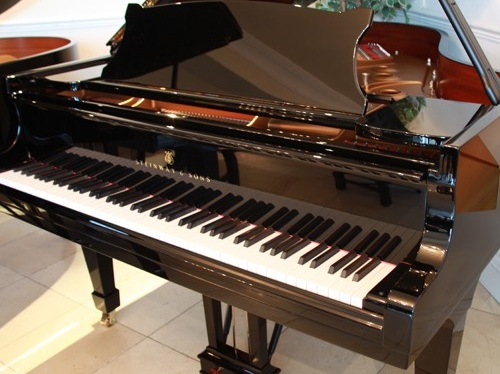
Piano components
Even if we're talking about grand pianos or upright pianos, its many parts are organized into 5 general areas: the case of the wing-shaped grand piano (or the cabinet
of the vertical or upright piano); the soundboard and the ribs and bridges
that are its components; the cast iron plate; the strings; and,
collectively, the keys, hammers, and piano action or mechanism.
The first piece of the piano that we see and most attracts us is the keyboard. As you probably know, almost every modern piano has 88 keys (52 white and 36 black), seven octaves + a minor third, from A0 to C8. In the early years of piano construction, keys were commonly made from sugar pine. Today they are usually made of spruce or basswood. Spruce is typically used in high-quality pianos. Black keys were traditionally made of ebony, and the white keys were covered with strips of ivory.
However, since ivory-yielding species are now endangered and protected
by treaty, makers use plastics almost exclusively. Also, ivory tends to
chip more easily than plastic. Legal ivory can still be obtained in
limited quantities. The Yamaha
firm invented a plastic called "Ivorite" that they claim mimics the
look and feel of ivory. It has since been imitated by other makers.
In order to produce sound, one must press at least one key. All keys are part of a hammer-action mechanism, pressing a key triggers (with the help of the mechanical system which is in place) the afferent hammer to strike a specific string (or strings), the hammer rebounds, and the strings continue to vibrate at their resonant frequency.
The strings which must endure years of extreme tension and hard blows, are made of high carbon steel. The bass strings of a piano are made of a steel core wrapped with
copper wire, to increase their mass whilst retaining flexibility. If all
strings throughout the piano's compass were individual (only one string), the
massive bass strings would overpower the upper ranges. Makers
compensate for this with the use of double (2 strings) strings in the
tenor and triple (3 strings) strings throughout the treble. The 220 to 240 strings of the piano are attached to
hitch pins along the curved edge of the cast iron plate and to tuning pins
across the front of the piano, roughly parallel to the keyboard.
A massive plate is advantageous. Since the strings vibrate from the plate at both ends, an insufficiently massive plate would absorb too much of the vibrational energy that should go to through the bridge to the soundboard. While some manufacturers use cast steel in their plates, most prefer cast iron. Cast iron is easy to cast and machine, has flexibility sufficient for piano use, is much more resistant to deformation than steel, and is especially tolerant of compression. The pinblock, which holds the tuning pins in place, is another area where toughness is important. It is made of hardwood (typically hard maple or beech), and is laminated for strength, stability and longevity.
Because the vibrating piano strings themselves are not very loud, in order to produce that rich sound that a piano has, the vibrations are transmitted through a bridge to a soundboard that amplifies the sound. Some soundboards are made from plywood (laminated wood) but they are not as qualitative as the hardwood soundboards.
In order for the soundboard to do its job better (amplify the sound), a piano must have a sturdy rim (case). The purpose of a sturdy rim is so that the energy produced by the vibration of the strings will stay as much as possible in the soundboard instead of dissipating uselessly in the case parts, thus producing a much richer sound. In order to receive that effect the materials used for the rim must be qualitative. While many companies make hardwood rims by laminating thin (hence flexible) strips of hardwood plywood, bending them to the desired shape immediately after the application of glue, high-end manufacturers use a solid piece of wood. Bösendorfer, the Austrian manufacturer of high-quality pianos, constructs their rim from spruce, the same wood that the soundboard is made from. Their idea is to concertedly involve the cabinet in the projection and coloration of sound. The loss of energy into the Bösendorfer case alters the instrument's tone, giving it perhaps less power but a complex and unusually resonant sound.
And last but not least: pedals. Pianos have had pedals, or some close equivalent, since the earliest
days. (In the 18th century, some pianos used levers pressed upward by
the player's knee instead of pedals.) Most grand pianos in the US have
three pedals: the soft pedal (one string), sostenuto, and sustain pedal
(from left to right, respectively), while in Europe, the standard is
two pedals: the soft pedal and the sustain pedal. Most modern upright
pianos also have three pedals: soft pedal, practice pedal and sustain
pedal, though older or cheaper models may lack the practice pedal. In
Europe the standard for upright pianos is two pedals: the soft and the
sustain pedals.
